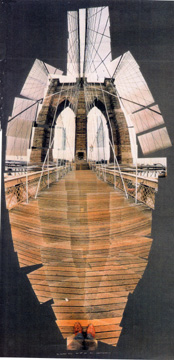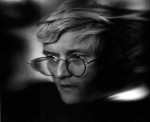
David Hockney
English, 1937- (active USA)
Brooklyn Bridge: #7, 1983
chromogenic print
109 × 57 7/8 in.
SBMA, Museum purchase, The Mary and Leigh Block Fund
1983.50

Portrait of Hockney by Stathis Orphanos
RESEARCH PAPER
Many critics consider David Hockney to be Britain’s most successful contemporary artist and the finest living draftsman of the human figure. His paintings, prints, drawings and photographs depict what the artist describes as landscapes of foreign lands, beautiful people, love, propaganda and major interests of his own life. Since he first appeared on the art scene in the mid sixties, he has received international recognition (his works are found in the most prestigious museums in the United States, Europe and Australia as well as in distinguished private collections throughout the world.)
In spite of the above high praise, other critics consider him a fashionable lightweight, limited and overestimated. To them, he treats his sitters with the detachment of a “Still Life,” a hair away from academic illustrations. To them the principle of his broad appeal is also the principle of his limitation; the attitude of disengagement without feeling, detached but not sympathetic, affectionate without being deeply committed – a compromise between sentimentality and subtle mockery.
Hockney was born in Bradford, Yorkshire, England in 1937 of a lower middle class family. He attended Bradford Art School where he spent twelve hours a day for four years learning to “draw.” He still has a capacity for hard work. Most of his early work was done in etchings and aquatints. A year after his postgraduate work at the Royal College of Art in London, he sold a series of etchings for five thousand pounds.
He taught briefly at universities in California, Iowa, and Colorado, but generally was able to support himself by the sales of his art. He has produced many paintings and drawings featuring the Southern California landscape and his friends there. He has been particularly fascinated with the color and rippling effects of the water of swimming pools.
He can be gregarious one moment and a loner the next. He freely discusses his homosexuality and depicts it frequently in his paintings and drawings. He rarely shows uncovered feet even in his nude drawings. Repeatedly, vases of daffodils are found in his works.
He admits to using ploys for drawing attention to his art – long titles written directly on his canvasses and additional “splurges” in group show catalogues. He says the viewer spends more time looking at and seeing his work. He acknowledges his influence on the art market and enthusiastically collaborates with the public relations process. In spite of his income, he is still puritanical about money matters and he continues to be an English taxpayer.
As an avid student of post-modern art, Hockney has appropriated and transformed twentieth century stylistic devices including the radiant colors and fluid brush strokes of the Fauves as well as Cubist devices of flat overlapping planes, shallow space boxes and geometrical forms. He speaks glowingly of Picasso, Matisse and Dufy.
In recent years he has been sought after as a stage and costume designer in England and the United States. In 1981 he did both for an experimental presentation of three composers for the New York Metropolitan Opera Company. Through his works he has come to believe there is a direct relationship between the vibrations of color and music.
He has been interested in photography for a period of time beginning in the 1960s forward, and has accumulated a collection of some thirty thousand photographs. He has, however, strong feelings about the limitations of photography for the painter. For him a photograph is merely an aid to composition and a prod to memory. It is just a glance in a second of time.With these drawbacks in mind he began to experiment by combining elaborate photographs “joining them up” as he explained it, looking for longer expanses of time as well as larger dimensions.
Brooklyn Bridge #7 is obviously a result of the “joining up” of various photographs. It commands scrutiny by the viewer. Its monumental size, its sculptured, even architectural, mass and its physical weight dominate the picture. At the same time, its rich color, seemingly drenched in light, is dramatic. The wood planking with darker shadows leading up to the brick spanned arch, the grid crossings and the subtle light spaces reflect the Fauve and Cubist influence. However, he leaves his personal mark on this work. His two feet at the bottom, the emphasis he gives to the graffiti markings as well as other printed and written words all add up to a tautly orchestrated composition of the artist’s uniqueness. He has mastered the limitations of time and size that concerned him in this photographic collage. The work is the seventh in a series. Some twenty-five were made. Hockney has used the silkscreen printing technique combining it with the photographic process.
Submitted by Alice S. Filie, 11/83
Prepared for Website by Terri L. Pagels, 1/04
